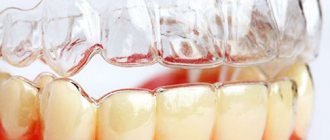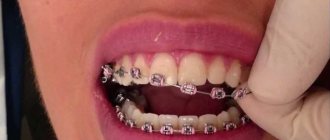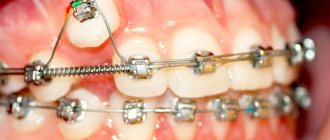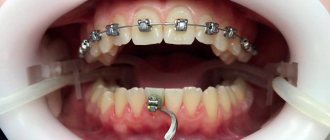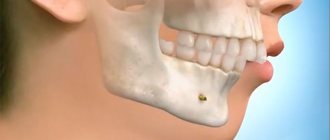In orthodontics, plates or braces are most often used to correct bite pathologies. These two types of structures successfully cope with the task assigned to them, but they are very different from each other in type, purpose, price, etc. Therefore, many patients are concerned with the question, which is better to use for braces or plates to correct the bite? Only through comparison will each patient be able to decide on the choice of the system that is suitable for him.
When are braces and plates used?
Braces and plates are used in different situations. It is better to use braces when the patient already has permanent teeth, that is, for children, adolescents and adults.
Plates are most often used to straighten baby teeth and when they are replaced by permanent teeth.
There are of course exceptions, and the plates can be used for an adult patient. It depends on the diagnosis and other reasons. But the effectiveness of the plate for straightening teeth in permanent occlusion is low, and it is better to use braces in such a situation.
Differences between braces and plates
Despite the fact that both plates and braces straighten teeth, these two designs have many differences.
The plate is placed over the teeth, and only metal fastening devices are visible on the front part of them. They are made using individual casts for each patient separately.
In addition, the platinums are a removable design, that is, they can be removed if necessary. This is usually done before meals, oral hygiene procedures, or when, for example, you need to speak in front of other people.
The material used for making plates is plastic, to which metal fasteners (arcs, springs, clasps, screws) are attached.
Braces are permanent structures used for more rigorous treatment. Each of the braces (a kind of locks) is attached to a separate tooth. Braces are made from different materials. Most often they are made of ceramics, which can be matched to the color of the enamel, making the bracket almost invisible. However, part of the brace system is a metal arch that penetrates each bracket and is quite noticeable on the teeth.
Which braces are best to choose?
It is impossible to say unequivocally that this system is good and this one is not. Each has its own pros and cons. The patient’s choice is influenced not only by his desires and capabilities, but also by the doctor’s recommendations. Depending on the situation, only metal braces and no others may be prescribed - you should be prepared for such nuances.
Also, an important choice factor for the patient is the amount of time that will be spent on treatment, because this directly affects his possible limitations or inconveniences in his daily life.
A dentist specializing in this area will help you understand the advantages and disadvantages of each orthodontic system.
Differences regarding treatment of bite problems
Plates are not used to move jaw elements. They are simply not able to move the jaw rows. Plates can only be used to hold teeth in the desired position. The teeth do not experience strong pressure from the plate, which is why it cannot cope with serious pathologies. But violations at the initial stage are within her power.
Let's look at the cases in which the plate can be used:
- The placement of the teeth is normal, but there is a possibility of displacement.
- The initial stage of incorrect displacement.
- There has been a recent deformation of the child's jaw.
- Problems with the width of the palate, on which the correct further development of the bite depends.
Braces put a stronger load on the teeth, so they can be used to cope with even significant pathologies.
Braces are indicated in the following cases:
- Jaw developmental defects.
- The anterior dental line is displaced.
- Some teeth have a pathological location.
- The profile is deformed, facial asymmetry is observed.
- The roots of the teeth have abnormalities.
- Some dental units are shortened or lengthened.
That is, with the help of braces you can not only prevent, but also correct malocclusions.
Vestibular and lingual apparatus
Orthodontists install braces in the oral cavity in two ways: on the vestibular (visible) and lingual (in contact with the tongue) side of the dentition. With the lingual type of fixation, aesthetic indicators are higher, but the period of adaptation to internal braces is more difficult. Patients with lingual devices do not experience psychological discomfort: the devices are almost invisible to others. The cost of invisible structures is higher compared to traditional vestibular systems.
lingual braces STb
Which design is better depending on age?
Plates are most often recommended for children and adolescents. Because in adulthood they are not always able to give the desired effect. It is best to use plates at a time when the bite is changing. Baby teeth are replaced by permanent teeth at about 12 years of age. It is at this time that various pathologies can arise. It happens that a permanent tooth does not appear in place of a fallen baby molar for a long time. At the same time, neighboring teeth begin to shift towards it, forming defects.
For adults, plates are sometimes recommended as an addition to basic malocclusion treatment. That is, they are placed after braces to prevent the teeth from returning to their original location.
Braces can be used at any age. Because of their harsh effects, even severe bite problems can be easily corrected. But age still has an impact on the duration of treatment with braces. The older the patient, the longer the structures will need to be worn. After 25 years, when the jaws and teeth stop developing intensively, metabolic processes slow down, so correction of the defect can take three years or even more. Up to 25 years of age, you can correct a bite problem in 6 to 18 months.
Braces or plates: choice by age category
The use of plates is advisable only at the initial stage of pathology development. Such devices will not be able to eliminate changes in the position of dental units; they can only hold or guide them. Therefore, plates have found wide application in the correction of children's occlusion. In modern pediatric dentistry, new technologies are used to create plates. It is advisable to begin treatment with such devices at the age of twelve. At this time, there is the greatest risk of developing deviations from the norm. Situations are especially dangerous when the milk unit has already fallen out and the molar does not grow. Then the neighboring units gradually begin to shift to the side, and defects appear.
For adults, plates are often prescribed in order to consolidate the results of treatment with braces. In this regard, braces are universal because they can be used for any age category. The devices are used in pediatric orthodontics to correct significant anomalies, and in adult orthodontics. Such devices are capable of eliminating even the most complex defects. The main difference is the duration of treatment.
Children typically wear braces less than adults. Since the teeth and jaw system is actively developing until the age of twenty-five, treatment with braces in children and adolescents is much faster and more effective. The approximate period of wearing braces in childhood is 6-18 months. Such devices cannot be purchased at a pharmacy. They are made purely individually in several stages. If you are planning to install such a device, you must first consult with an orthodontist.
Positive and negative sides of each design
It will become easier to find out how braces differ from plates, and which one is better, if you become familiar with the disadvantages and advantages of each design.
The advantages of the plates are the following:
- Possibility of removal when necessary (serious meeting, holiday, performance, etc.).
- Easy to care for.
- Affordable price.
Disadvantages of records:
- possibility of withdrawal (in addition to being a plus, it is also a minus). If you frequently remove the structure, treatment may be greatly inhibited and significantly lengthened, or may not have the desired effect at all;
- long period of adaptation. The plate interferes with chewing and talking for a long time;
- in the event of a breakdown, it will take a long time to repair or make a new structure, which will take time, and therefore may negatively affect the result of treatment;
- longer treatment than with braces;
- plates may not move teeth in all directions.
Pros of braces:
- Continuous impact on teeth thanks to non-removable design. This way the treatment is faster and better quality.
- It doesn't take long to get used to. Violations in diction occur extremely rarely and are mostly insignificant.
- Problems in the form of the arch moving out, the bracket coming off and other breakdowns can be eliminated in one visit to the orthodontist. The treatment is not interrupted.
- High speed of bite correction.
- Teeth can move in different directions.
Cons of braces:
- difficulties in care. The need to use various devices for high-quality cleaning;
- high price;
- low aesthetics when using metal structures.
Difference in care
Plates are easier to care for than braces because they can be removed. It is enough to thoroughly clean the teeth, and then the plate itself. To do this, use a soft-bristled brush and toothpaste.
Caring for fixed braces is much more complicated. Cleaning the oral cavity should be done as carefully as possible to avoid damage to the structure.
For oral hygiene in which braces are located, the following devices and means are needed:
- Fluorine-containing paste with a gentle effect.
- Cleaners or brushes with a special shape of bristles.
- Floss.
- Irrigator.
- Antibacterial rinse.
Also, when wearing both braces and plates, professional cleaning in the dental office is sometimes required, usually carried out every six months.
Advantages of aligners over braces
The two main advantages - aesthetics and wearing comfort - are due to the design of this product. This allows you not to experience embarrassment during treatment, as happens when wearing braces, when a person is embarrassed to smile and talk, experiencing stress and becoming withdrawn, refusing to communicate. Aligners eliminate such problems - they make you look the same as usual, and in extreme cases they can be removed altogether.
Aligners are more effective than braces in another respect: there are almost no restrictions on food intake. Even solid foods can be eaten if they are removed before meals. It is impossible to remove the braces for a while, so you will have to eat in them, which means you will have to give up solid food, which can break the structure, and after eating, rinse your mouth thoroughly and brush your teeth using special brushes and toothpicks, since food gets stuck between them much more strongly. teeth.
Well, difficulties in oral hygiene will result in the development of caries if the patient allows himself to relax and not be too diligent in caring for the oral cavity. When using aligners, such problems do not arise, you can eat and brush your teeth as usual.
Finally, what makes you choose aligners instead of braces is their purely medical effectiveness - treatment with aligners is faster, and you can change the aligners yourself if necessary. Aligners cover the teeth more tightly and transfer the load to them more evenly, allowing them to be moved in several axes at once, which speeds up treatment and at the same time makes it safer and more comfortable.
Price difference
The cost of braces and plates varies greatly. Many patients pay special attention to this aspect when choosing a design. The price of the plates is affordable for almost every patient and the minimum is 3 thousand rubles.
Braces are much more expensive. The cheapest are metal products. They cost from 36 to 107 thousand rubles. Braces made of artificial sapphires will cost 85-175 thousand rubles. Ceramic ones are a little more affordable at a price that ranges from 56 to 133 thousand rubles.
An alternative to braces is aligners.
In many cases, aligners can be used instead of inconvenient braces. Their key feature is that it is a removable structure made of transparent plastic that fits tightly to the teeth. This option is indispensable for those who, for some reason, cannot allow their appearance to change, because braces are clearly visible when talking and smiling, and they will have to be worn for several months, sometimes even up to 2 years. Of course, there are braces that are less noticeable, made of polymer or ceramic materials, as well as lingual braces, which are placed not on the outside, but on the inside of the dentition, but they cannot always be used, and their cost is much higher than usual.
Aligners are an analogue of braces, since they use the same general principle - applying constant pressure to the teeth in order to move them in the desired direction. The only difference is in the design, and as a result, in some functions and properties. Firstly, they are transparent, which makes them very unnoticeable from the outside, and secondly, they can generally be removed during an important meeting or photo shoot. To achieve the desired effect, aligners must be worn 20-22 hours a day, so you can always find time for meals or negotiations to remove the aligners for a while.
The difference between aligners and braces includes several important points:
- aesthetic – unlike braces, they are not visible,
- mechanics of impact – more evenly distributes pressure on each tooth,
- removable - they can be removed, hence there are fewer restrictions on food intake and easier hygiene,
- allergenicity - are made of hypoallergenic plastic, and braces are made of metal.
An orthodontist will help you decide to use aligners or braces in case of dental alignment, based on the specific clinical situation, individual characteristics and requirements of the patient.
